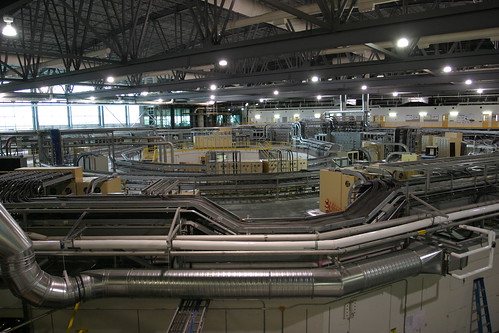'sup internet.
Edmonton is a city with notoriously hard water. Fortunately, I was lucky enough to grow up in a home with salaciously soft water (courtesy of a hulking ion-exchange softner[1]).
Yea, I did grow mighty accustomed to the benefits of soft water lo those many years of living with my parents: soap that actually lathered, glasses without a scummy-looking residue on them, lower heating bills, etc. Moving out has been nothing but a bitter pill to swallow and a ring around my bathtub.
I had vauge plans to install an expensive and time-consuming water softener, eventually, but my dear ol' father instead took the initiative and bought me a Water King (slogan: "using intelligent electronics to improve on nature's work"). This apparently has several advantages over normal softeners, namely:
- it's pretty cheap- ours cost about $300, and there are larger versions for hotels available (for comparison, a regular softner will set you back about $1000-$1500).
- it's suspiciously easy to install- it's about the size of a brick, and sits atop your incoming water stream.
- it works on... SCIENCE!
- no, seriously- it actually works on some crazy ass science. Here's how they say it works:

Now, last time I checked, Ca2+ was kind of boring, magnetically. How the schnitzel would putting it in an electromagnet do *anything* with regards to its crystal structure? Somewheres, poor ol' Pierre Curie is rolling in his grave.
Well, actually maybe not so much. A cursory search in the literature seems to actually check out with some of their claims:

Article: L.C. Lipus, D. Dobersekb. "Influence of magnetic field on the aragonite precipitation," Chemical Engineering Science 62 (2007) 2089 – 2095. DOI:10.1016/j.ces.2006.12.051.
Infinifluxotron, forever!
Joel
[1] Once, and once only, my family tried for some reason to replace the KCl salt in the softner. We spent about 5 hours shovelling the salt into, of all things, a giant cardboard box. I know, I know. Not the brightest decision. Once we had dug all of the salt into our now ridiculously overfull box, we dragged it somehow outside to the alley, to be taken away by the dump truck the next day. Of course, they wouldn't take it, being smart enough not to lift a 50kg box filled with a smelly white powder.
[2] I hate to admit it, but this is probably one of the first papers in a long time that I've read and taken the time to understand outside my (far too narrow) area of study. Which reminds me about the subject of an upcoming post.

3 comments:
Usually when you hear stuff about magnetic or electric fields acting on water, its all just crazy quakery.
I feel cheated and wronged that this actually works.
So that's what that crap is that keeps building up in my bathroom sink pipes! I'm glad to see that an explanation given by a company isn't actually all BS for once.
I agree with Jons; these companies are supposed to be employing pseudoscience for me to mock and scoff at.
Hmm for some reason I feel that I've seen this image before.
And I just now see the date on this post; that'll explain it. When I switched over to your Feedburner feed, all of those posts appeared new to me again. Oh well.
Post a Comment